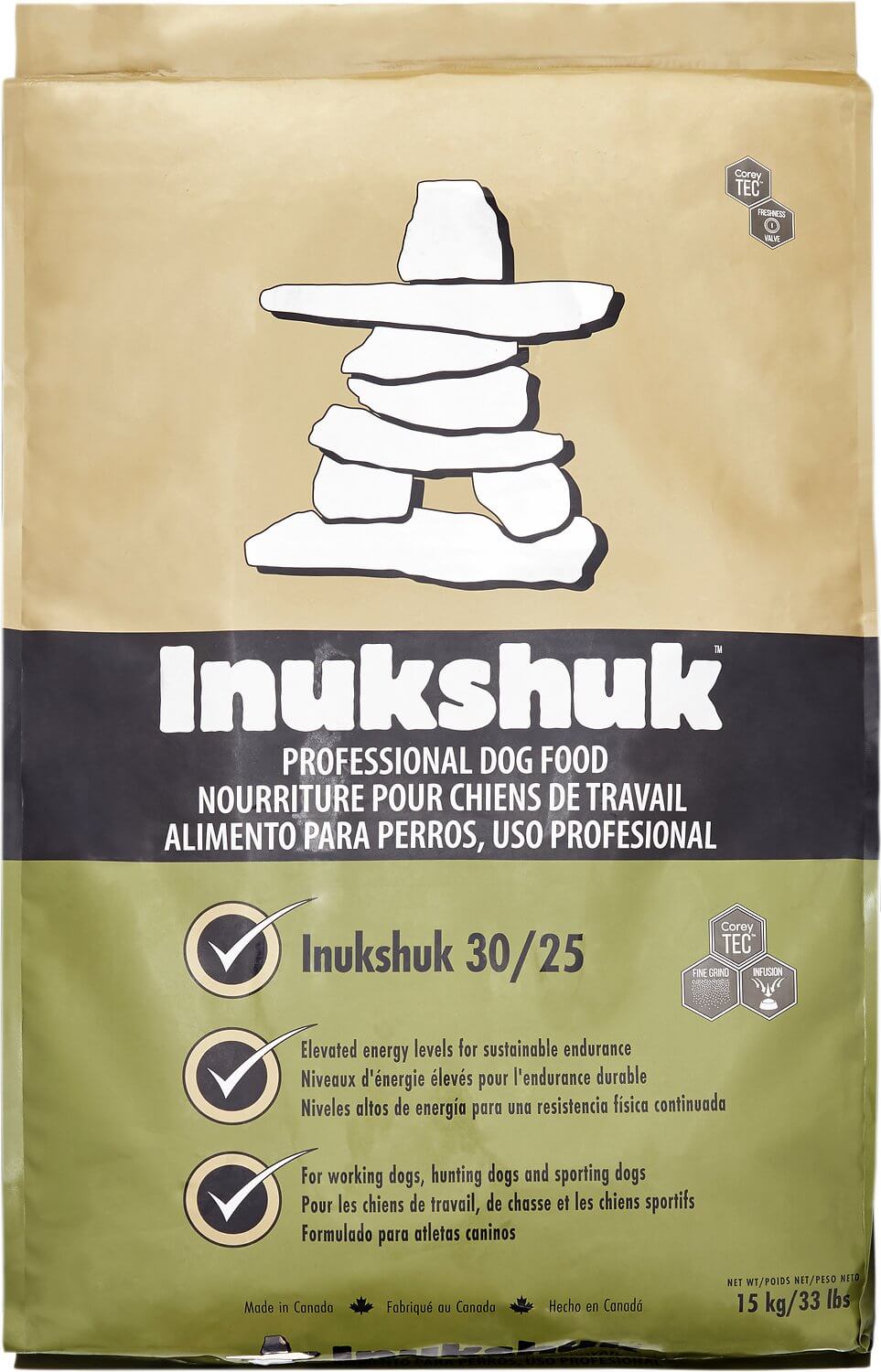
DogFoodAdvisor is reader supported See how
All reviews are 100% impartial but if you buy using links on this page, we may earn a referral fee.
Our Verdict
Inukshuk Professional Dog Food product range is made up of five recipes with ratings varying from 2 to 4 stars. The average rating of the whole range is 3.5 stars.
Please note: some recipes have been down rated for very high fat to protein ratio, but we understand that this is by design, as they are high energy formulas. For working and sporting dogs, these would receive a higher rating, but as our method is designed for pets, this doesn’t receive a high rating.
Pros
- Locally sourced ingredients
- High in protein
- Contain prebiotics and probiotics
Cons
- Some recipes are not suitable for all breeds due to fat content
The table below shows each recipe in this range including our rating and the AAFCO nutrient profile: Growth (puppy), Maintenance (adult), All Life Stages, Supplemental or Unspecified.
| Product line | Rating | AAFCO |
|---|---|---|
| InukShuk 26/16 - All Life Stages | 4 | A |
| InukShuk 30/25 - High Energy Formula | 3.5 | A |
| Inukshuk 32/32 - Extreme Energy | 2 | M |
| Marine 16 - All Life Stages | 4 | A |
| Marine 25 - High Energy Formula | 3.5 | M |
Recipe and Label Analysis
Inukshuk 30/25 – High Energy Formula was selected to represent the other products in the line for detailed recipe and nutrient analysis.
Inukshuk 30/25 - High Energy Formula
Estimated Dry Matter Nutrient Content
Protein
Fat
CarbsCarbohydrates
Chicken meal, chicken fat, herring meal, ground whole grain corn, ground whole grain wheat, whole brown rice, wheat shorts, dried beet pulp, dried brewer’s yeast, herring oil, salt, chicken liver, kelp meal, calcium carbonate, potassium chloride, lecithin, chicory root, malted barley flour, calcium propionate, flaxseed, taurine, ferrous sulfate, zinc sulfate, l-ascorbyl-2-polyphosphate, zinc methionine complex, yucca schidigera extract, l-lysine hydrochloride, niacin supplement, calcium pantothenate, copper proteinate, manganese proteinate, riboflavin (B2), vitamin A supplement, calcium iodate, vitamin D-3 supplement, thiamine mononitrate (B1), pyridoxine hydrochloride (B6), cobalt sulfate, folic acid, selenium yeast, biotin, vitamin B-12 supplement, vitamin E supplement
Fiber (estimated dry matter content) = 3.5%
Red denotes any controversial items
| Estimated Nutrient Content | |||
|---|---|---|---|
| Method | Protein | Fat | Carbs |
| Guaranteed Analysis | 30% | 25% | NA |
| Dry Matter Basis | 33% | 28% | 31% |
| Calorie Weighted Basis | 25% | 51% | 24% |
Ingredients Analysis
The first ingredient in this dog food is chicken meal. Chicken meal is considered a meat concentrate and contains nearly 300% more protein than fresh chicken.
The second ingredient is chicken fat. This item is obtained from rendering chicken, a process similar to making soup in which the fat itself is skimmed from the surface of the liquid.
Chicken fat is high in linoleic acid, an omega-6 fatty acid essential for life. Although it doesn’t sound very appetizing, chicken fat is actually a quality ingredient.
The third ingredient is herring meal. Because it is considered a meat concentrate, herring meal contains almost 300% more protein than fresh fish itself.
Fish meal is typically obtained from the “clean, dried, ground tissue of undecomposed whole fish and fish cuttings” of commercial fish operations.1.
The fourth ingredient is corn. Corn is an inexpensive and controversial cereal grain. And aside from its energy content, this grain is of only modest nutritional value to a dog.
For this reason, we do not consider corn a preferred component in any dog food.
The next ingredient is wheat. Wheat is another cereal grain and subject to the same issues as corn (previously discussed).
The sixth ingredient is brown rice, a complex carbohydrate that (once cooked) can be fairly easy to digest. However, aside from its natural energy content, rice is of only modest nutritional value to a dog.
The seventh ingredient includes wheat shorts, the fine particles of wheat bran, wheat germ, wheat flour and other processing waste from what’s known as the “tail of the mill”.
Similar to wheat middlings, wheat shorts are nothing more than an inexpensive by-product of cereal grain processing.
In reality, wheat middlings are nothing more than milling dust and floor sweepings — and an ingredient more typically found in the lower quality pet foods.
The eighth ingredient is beet pulp. Beet pulp is a controversial ingredient, a high fiber by-product of sugar beet processing.
Some denounce beet pulp as an inexpensive filler while others cite its outstanding intestinal health and blood sugar benefits.
We only call your attention here to the controversy and believe the inclusion of beet pulp in reasonable amounts in most dog foods is entirely acceptable.
The ninth ingredient is brewers yeast, which can be a controversial item. Although it’s a by-product of the beer making process, this ingredient is rich in minerals and other healthy nutrients.
Fans believe yeast repels fleas and supports the immune system.
Critics argue yeast ingredients can be linked to allergies. This may be true, but (like all allergies) only if your particular dog is allergic to the yeast itself.
In addition, a vocal minority insists yeast can increase the risk of developing the life-threatening condition known as bloat. However, this is a claim we’ve not been able to scientifically verify.
In any case, unless your dog is specifically allergic to it, yeast can still be considered a nutritious additive.
What’s more noteworthy here is that brewers yeast contains about 48% protein, a factor that must be considered when judging the actual meat content of this dog food.
From here, the list goes on to include a number of other items.
But to be realistic, ingredients located this far down the list (other than nutritional supplements) are not likely to affect the overall rating of this product.
With six notable exceptions…
First, we find herring oil, which is naturally rich in the prized EPA and DHA type of omega-3 fatty acids. These two high quality fats boast the highest bio-availability to dogs and humans.
Depending on its level of freshness and purity, herring oil should be considered a commendable addition.
Next, chicory root is rich in inulin, a starch-like compound made up of repeating units of carbohydrates and found in certain roots and tubers.
Not only is inulin a natural source of soluble dietary fiber, it’s also a prebiotic used to promote the growth of healthy bacteria in a dog’s digestive tract.
In addition, we find taurine in this food. Taurine is an important amino acid associated with the healthy function of heart muscle. Although taurine is not typically considered essential in canines, some dogs have been shown to be deficient in this critical nutrient.
Next, flaxseed is one of the best plant sources of healthy omega-3 fatty acids. Provided they’ve first been ground into a meal, flax seeds are also rich in soluble fiber.
However, flaxseed contains about 19% protein, a factor that must be considered when judging the actual meat content of this dog food.
This product also includes chelated minerals, minerals that have been chemically attached to protein. This makes them easier to absorb. Chelated minerals are usually found in better dog foods.
And lastly, this recipe contains selenium yeast. Unlike the more common inorganic form of selenium (sodium selenite), this natural yeast supplement is considered a safer anti-cancer alternative.
Nutrient Analysis
Judging by its ingredients alone, Inukshuk 30/25 – High Energy Formula looks like an average dry product.
The dashboard displays a dry matter protein reading of 34.2%, a fat level of 28.3% and estimated carbohydrates of about 23.7%.
As a group, the brand features an average protein content of 32.9% and a mean fat level of 25.9%. Together, these figures suggest a carbohydrate content of 27.2% for the overall product line.
And a fat-to-protein ratio of about 77%.
Above-average protein. Above-average fat. And below-average carbs when compared to a typical dry dog food.
Even when you consider the protein-boosting effect of the brewers yeast and flaxseed, this looks like the profile of a kibble containing a significant amount of meat.
Inukshuk Dog Food Recall History
The following automated list (if present) includes all dog food recalls related to Inukshuk through December 2025.
No recalls noted.
You can view a complete list of all dog food recalls since 2009 here.
Our Rating of Inukshuk Professional Grain Inclusive Dog Food
Inukshuk Professional is a grain-inclusive dry dog food using a significant amount of named meat meals as its dominant source of animal protein, thus earning the brand 3.5 stars.
Compare Inukshuk Professional Dog Food
How does Inukshuk Professional compare with The Dog Food Advisor's most recommended brands?
A Final Word
The Dog Food Advisor does not accept money, gifts, samples or other incentives in exchange for special consideration in preparing our reviews.
However, we do receive a referral fee from online retailers (like Chewy or Amazon) and from sellers of perishable pet food when readers click over to their websites from ours. This helps cover the cost of operation of our free blog. Thanks for your support.
For more information, please visit our Disclaimer and Disclosure page.









